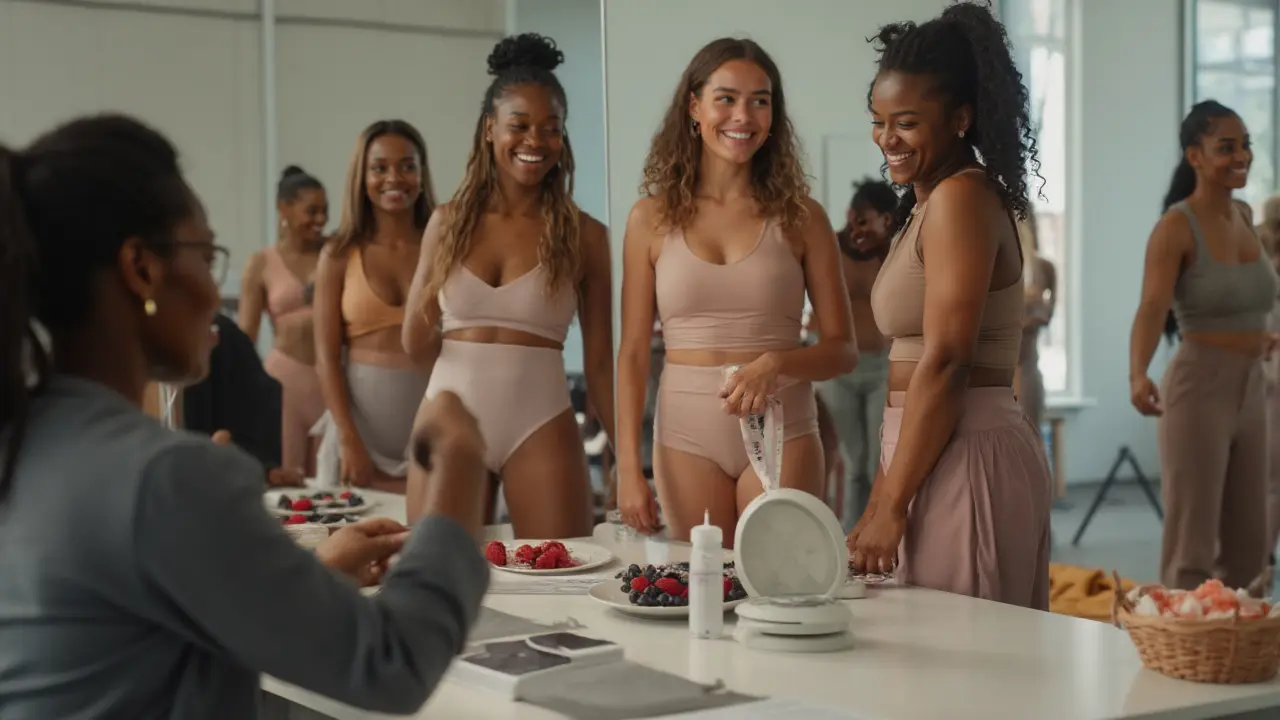You want a straight answer: what body fat percentage do Victoria’s Secret models sit at? Here’s the truth you can actually use. There isn’t one magic number. The runway-ready look usually lands in a lean range, and it shifts with genetics, season, and how you measure it. I’ll give you realistic percentages, show how they’re measured, what each range looks like, and how to aim for it safely-without wrecking your energy, hormones, or headspace.
TL;DR: The Quick Answer
- Most Victoria’s Secret-style runway bodies show up around 16-20% body fat during peak shoots/shows, with many sitting closer to 17-19% when they’re at their leanest.
- Off-season or between campaigns, many models hover closer to 18-22% and still look very lean on camera.
- The exact number depends on genetics and fat distribution. Two women at the same body fat can look very different in the mirror and on the runway.
- Measurement method matters. DXA often reads 2-4 percentage points higher than calipers; BIA scales can swing wildly with hydration. Expect a 3-5% spread across methods.
- Health trade-offs are real. Many women need roughly 18-22% or more to keep periods regular and energy stable (Endocrine Society guideline on functional hypothalamic amenorrhea, 2017; IOC consensus on RED-S, 2018/2023). Pushing below ~16% can increase risks for some.
Step-by-Step: Estimate and Track Your Body Fat the Right Way
If you want a clean number you can trust (and compare over time), do it like a pro. Chasing a single reading without a system is how people get frustrated-or hurt.
Pick one primary method and stick with it. Best to decent, in order:
DXA scan: gold-standard in the field for practicality. It often reads a bit higher than calipers. Expect day-to-day repeatability if you prep the same way.
7-site or 3-site skinfold calipers (skilled technician): useful for trends; error often ±3-4% vs. DXA. Technique matters a lot.
BIA scales/handhelds: fine for trends at home but highly sensitive to hydration, sodium, and time of day. Single readings can be off by 3-8%.
Pro tip: If you’re close to an important target, get a DXA and use calipers for weekly check-ins.
Standardize your conditions. Measure first thing in the morning, after using the bathroom, before eating or drinking, and not right after hard training. Same scale, same device, same day of the week.
Add tape and photos. Take relaxed front/side/back photos in consistent light. Record waist (narrowest), hip (widest), and thigh. Many pros care more about girths and how clothes fit than an exact percent.
Track the trend, not the noise. Look at 2-4 week averages. Body water can jump 1-3% from hormones alone, especially around your cycle.
Interpret using categories. For women, the American Council on Exercise (ACE) lists rough categories: Athletes 14-20%, Fitness 21-24%, Average 25-31%, Obese 32%+. VS-style runway leanness generally sits in the upper “Athlete” band or the low end of “Fitness.”
Set sane timelines. If you’re at ~25% and aiming for ~18-20%, plan 8-16 weeks depending on your size and pace. Faster isn’t better if health and performance matter.
Safety lens: The IOC’s RED-S guidance and the Endocrine Society’s amenorrhea guideline both warn that low energy availability-not just low fat-disrupts hormones. If you’re skipping periods, having cold hands/feet, insomnia, brittle nails, or big mood swings, hit pause and fuel up.

Examples and Benchmarks: What 15-25% Looks and Feels Like
Numbers mean very little without a picture in your head. Here’s a way to visualize ranges, plus why two people at the same number can look different.
Visual cues by percentage (women):
~25%: You look healthy and feminine, with soft definition. Outline of abs may show in great lighting. Clothes fit predictably. Most active women live here.
~22%: Noticeable waistline, upper-abs outline in good light, defined delts with a small cap on flex. Arms and legs look lean; glutes still full. Easy to maintain for many.
~20%: Clearer lines around shoulders and hips, faint ab lines, some quad separation in motion. This often reads lean on camera without looking “stringy.”
~18%: Visible top two abs in neutral light, more shoulder striations, sharper jawline on some faces. This is a common runway/photoshoot “on” look for VS-style bodies.
~16%: Prominent ab lines, vascularity in forearms for some, glute-ham tie-in starts to pop. This is lean and not sustainably comfortable for everyone.
~14%: Very sharp muscular detail. For many women this is athletic-stage lean and can be hard to maintain without hormonal trade-offs.
Distribution changes everything. A “pear-shaped” woman can be 20% with very lean arms and abs but more lower-body fat, reading leaner on camera. An “apple-shaped” woman might store more centrally and look less lean at the same percent. That’s why some models look camera-ready at 20-21%, while others feel they need 17-18%.
Runway vs. off-season reality. A lot of models sit around 18-22% most of the year, then taper down 1-3 points for a big shoot. The tiny difference is a big visual change under studio lighting and pump-up routines.
Weight examples to ground it (purely illustrative).
5’9” model with a DXA at 19% might weigh 130-138 lb depending on muscle and frame. The same model at 22% could be 135-145 lb with no real drop in booking potential if measurements stay on-spec.
5’10” model, strong lower body, at 18% could look similar on runway to a 5’9” model at 20%. Limb leanness and bone structure change the look-per-percent far more than people expect.
Measurement quirks that confuse people:
DXA vs. calipers: DXA often reads 2-4 points higher than a skilled 7-site caliper session on the same day. Don’t compare your DXA to your friend’s gym caliper reading.
Hydration swings: BIA readouts can shift 2-3 points in a single day from glycogen and sodium changes. If your number “jumps,” check your water and carb intake before panicking.
Cycle effects: In the late luteal phase, water retention can hide definition and nudge scale weight up. Many pros schedule shoots just after their period for clearer lines and a calmer gut.
Category snapshot (women):
| Category | Body Fat % (ACE) | Camera Look |
|---|---|---|
| Athlete | 14-20% | Defined, athletic lines; common for runway peak |
| Fitness | 21-24% | Lean with softer lines; great in lifestyle shoots |
| Average | 25-31% | Healthy, everyday look; still photogenic with styling |
Note: Many Victoria’s Secret-style models live between upper Athlete and lower Fitness most of the year and time the leanest look for show windows.
Checklists and Cheatsheets: Safe Fat-Loss Rules and Red Flags
If you’re aiming for a lean, runway-ready look, lead with health. A stable, fueled body looks better, performs better, and lasts longer.
Safe fat-loss rules of thumb:
Set pace: Lose 0.5-1.0% of body weight per week. Smaller frames do better closer to 0.5%.
Protein anchor: 1.6-2.2 g/kg per day. Split across 3-5 meals. It keeps fullness and muscle.
Fiber baseline: ~14 g per 1,000 kcal (Institute of Medicine). Veg, fruit, legumes, whole grains.
Steps first: 8-12k daily. Then lift 2-4x/week to hold shape. High-intensity work 1-2x/week if recovery is solid.
Sleep: 7-9 hours. Poor sleep raises hunger hormones and water retention, blurring definition.
Diet breaks: After 8-12 weeks, take 1-2 weeks at maintenance calories. Performance and hormones thank you.
Hydration and sodium: Keep both steady. Big swings = weird weigh-ins and BIA chaos.
Micros matter: Iron, calcium, vitamin D, and omega-3s support energy, bones, and mood. A simple multivitamin can fill gaps if your diet is tight.
Red flags to stop and reassess (don’t push through):
Loss of menstrual cycle, or cycles getting unusually light or far apart.
Cold intolerance, hair shedding, brittle nails, persistent fatigue, dizziness.
Compulsive body checks, food anxiety, or binge-restrict cycles.
Injuries or frequent illness; your immune system and connective tissue are waving a flag.
These are classic signs of low energy availability and are tied to RED-S (IOC consensus, 2018/2023) and functional hypothalamic amenorrhea (Endocrine Society CPG, 2017). Health first, look second. You’ll actually look better when you’re fueled.
How agencies and clients really assess:
They rarely ask for your body fat percent. They care about measurements (bust/waist/hip), proportions, posture, gait, and how garments drape.
Leanness is one dial among many-skin quality, hair, expression, and presence matter just as much.
Different bookings call for different looks. Beauty and lingerie often prefer “healthy-lean” (~18-22%) with fullness. High-fashion runway sometimes leans sharper (~16-19%).
Prep timeline example:
Starting at ~24-25%: Spend 2-3 weeks at maintenance to stabilize habits, then 8-12 weeks of gentle fat loss. Insert a 1-2 week diet break if needed. Peak in the 18-20% window for your shoot.
Starting at ~21-22%: 4-8 weeks of small deficit and extra steps might be enough to reveal the lines you want, no heroic cuts required.
Measurement cheat card:
Primary method: DXA if accessible; calipers by a trained pro if not.
Consistency: Morning, fasted, same device, same day, same conditions.
Context: Pair numbers with photos, tape, and energy/mood logs.
Quick sanity check: If the only way you can hit a number is by feeling worse every week, it’s the wrong number for your body right now.

Mini-FAQ: Your Top Questions, Answered
What body fat percentage are Victoria’s Secret models, really?
Most fall around 16-20% at their leanest for runway and shoots, and often 18-22% off-season. Remember: measurement method can shift a reading by a few points.
Is 15% body fat healthy for women?
It can be temporarily workable for some highly supported athletes, but many women experience hormone and energy issues below ~16-18%. The Endocrine Society’s guidance on functional hypothalamic amenorrhea and the IOC’s RED-S consensus stress fueling adequacy more than chasing a specific percent.
Do I need to be under 18% to “look like a model”?
Not necessarily. If your fat sits more in the hips and glutes and your limbs stay lean, you can read runway-lean at 19-21%. Lighting, pump, tan, and posing also work magic.
What’s the best way to measure at home?
Pick one: a consistent BIA scale for trends plus tape and photos, or a monthly visit to a gym pro for calipers. If you’re making big decisions, schedule a DXA every 8-12 weeks.
How long to go from 25% to 18%?
For many, 10-16 weeks at a gentle pace works. Smaller frames or busy schedules may need longer. Plan for at least one diet break.
Is BMI useful here?
Not for this question. BMI doesn’t capture body composition. Use body fat estimates, tape, photos, and how sample sizes fit.
Do clients care about the actual percentage?
Rarely. They care about how the garment fits, your presence, and whether you match the brand’s storyboard. Measurements and look beat any number on a device.
What about bone health?
Very low energy availability raises stress hormones and can reduce bone density over time. ACSM and IOC position statements flag menstrual loss and stress fractures as warning signs. Sufficient calories (especially carbs), calcium, and vitamin D matter.
Any pro nutrition targets?
Protein 1.6-2.2 g/kg/day, at least 2 servings of dairy or calcium-rich equivalents, omega-3s 1-2 g/day EPA+DHA, and carbs scaled to training. Keep sodium steady to avoid confusing the scale.
Bottom line number, one more time?
The camera-ready range for this look tends to be ~16-20%, with a healthy-living lane around 18-22% for most models between big gigs. That’s the most realistic Victoria's Secret body fat percentage answer you’ll find.
One last thing: numbers are tools, not identities. Use them to guide training and recovery, not to judge your worth. The best look is the one you can sustain while feeling strong, calm, and alive.






September 17, 2025 AT 13:40
Hey everyone, just wanted to add that the numbers in the post are useful but remember each body is a unique machine, so don’t let a single percent define your worth. It’s totally fine to aim for a healthy range that matches your lifestyle and genetics, and you can still look amazing at 20‑22% definatly.